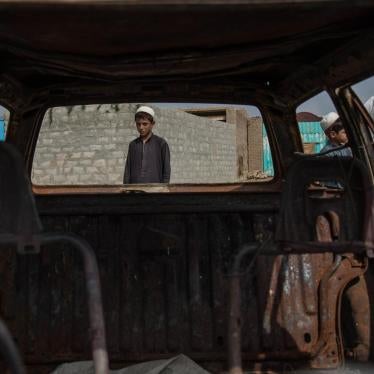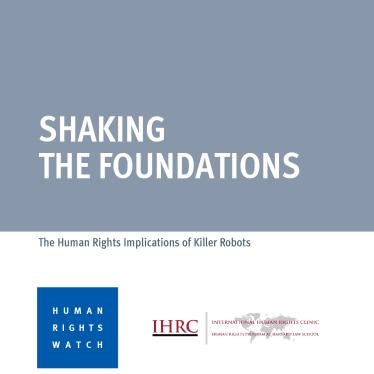This briefing was sponsored by the US Campaign to Ban Landmines and moderated by its coordinator, Scott Stedjan of the Friends Committee on National Legislation. It was held from 1:30-3:00 during a mid-day break of the Nairobi Summit, and was attended by diplomats, NGOs and numerous members of the media.
Tuesday, 30 November 2004
On 27 February 2004 the Bush administration completed a two and one-half year review of US landmine policy. The ICBL, US Campaign to Ban Landmines and Human Rights Watch all sharply criticized the new policy as a major step backward for the US.
Under the new policy, the US abandons its stated objective of the past 10 years of eventually eliminating all antipersonnel mines. It abandons the objective of joining the Mine Ban Treaty by 2006 if alternatives to antipersonnel mines are identified and fielded. The US now intends to retain certain types of antipersonnel mines indefinitely. The US has thus become the first country to state that it will never join the Mine Ban Treaty.
The US State Department gives this reason for the policy reversal: "The United States will not join the [Mine Ban Treaty] because its terms would have required the US to give up a needed military capability.... Landmines still have a valid and essential role protecting United States forces in military operations.... No other weapon currently exists that provides all the capabilities provided by landmines." We are told the most powerful and sophisticated military in the world must have antipersonnel mines, even though nearly every one of its major military allies has given them up as an outmoded and inhumane weapon of the past.
The new policy characterizes landmines according to their active lifespan (or "persistence" to use the government's term), and re-frames the focus from antipersonnel mines, which are comprehensively prohibited by the Mine Ban Treaty, to all types of landmines, both antipersonnel and antivehicle.
Under the new policy, US forces will be able to use self-destructing and self-deactivating antipersonnel and antivehicle mines indefinitely, without any geographic restrictions. These are the types of mines designed to blow themselves up after a set period of time; they are often called "smart" mines, and the US now calls them "non-persistent" mines.
US forces will also be able to use "persistent" antipersonnel mines (those without self-destruct mechanisms, often called "dumb" mines, which can lie in wait for victims for decades) in Korea until 2010. This moves back four years the Clinton administration's target date for halting dumb mine use in Korea. In a new development, the US has said it will also stop using "persistent" antivehicle mines after 2010.
In addition to abandoning the objective of joining the Mine Ban Treaty by 2006, the Bush administration has abandoned the formal policy commitment announced in 1997 to stop using all antipersonnel mines by 2003 -- except those in "mixed systems" (combining antipersonnel and antivehicle mines) and except for use in Korea. The main aspect of that policy was that after 2003, the US would no longer use any of its 8.4 million ADAM artillery-delivered antipersonnel mines, which are self-destructing mines. Now, the US will keep its ADAM mines, which constitute about 80 percent of the overall US stockpile of 10.4 million antipersonnel mines.
At its heart, the new policy is just dusting off the US "smart" mine policy from the mid-1990s, with its emphasis on promotion of self-destructing and self-deactivating mechanisms. The US tried to convince the treaty negotiators in Oslo in 1997 to make an exception for these types of mines, claiming they did not pose dangers to civilians. The US sent a team of generals to convince the US's closest military allies, and they failed. They failed for a number of reasons that are still valid today. Smart mines are not safe mines; they have failure-to-destruct rates and failure-to-arm rates; they are usually used in great numbers and spread over huge areas, impossible to map or mark; while active, they are indiscriminate just like dumb mines; they will deny land and endanger civilians and require clearance operations. The 144 States Parties to the Mine Ban Treaty understand all this. The United States stands alone in seeking a technological solution to the antipersonnel mine problem. Many nations have also argued that it would be unacceptable to permit wealthy nations to use sophisticated and expensive mines, but expect poorer nations to give up the cheap dumb mines available to them.
There are several other notable elements of the policy review that I have not yet mentioned, including a commitment to negotiate an international ban on the export of persistent landmines; a renewed research and development program for future self-destructing mines; and a pledge to increase US mine action funding.
The funding pledge is welcome, and further cements the US's position as the largest single country donor to mine action (in terms of overall expenditures, though not in terms of spending per capita or as percentage of GNP). It reverses two straight years of decreased mine action funding by the US (in fiscal years 2001 and 2002).
The pledge to stop the use of long-lasting antivehicle mines is also welcome (even if it is six years distant), and puts the US out front in the efforts to deal with the negative consequences of antivehicle mines. The dangers of antivehicle mines to civilians have been amply discussed in recent years in the deliberations of the Convention on Conventional Weapons (CCW). It should be noted though, that the US-backed proposal on antivehicle mines in the CCW is rather modest, and falls far short of a ban on use of persistent mines.
Apart from the funding increase and the antivehicle mine announcement, the rest of the new policy is bad news. It is bad news for the US and for the broader movement to eliminate antipersonnel mines. The reversal is especially regrettable because the US has been in many respects in de facto compliance with the Mine Ban Treaty for many years. The US has not, to our knowledge, used antipersonnel mines since the Gulf War in 1991. It has prohibited export of all antipersonnel mines since 1992. It has not produced antipersonnel mines since 1997. It has destroyed some 3.3 million stockpiled "dumb" antipersonnel mines. The US military does not maintain minefields anywhere in the world, having cleared its minefields in Cuba in 1999. And, of course, it is a world leader in providing funds for the mine clearance and survivor assistance. However, both the Clinton and Bush administrations have lacked the political will to join the Mine Ban Treaty.
While regrettable, the new US policy is hardly a "death blow" to the global ban effort or to the Mine Ban Treaty. The treaty has been functioning extremely well without the support of the United States for many years and will no doubt continue to do so in the future. The commitment of other governments to the total eradication of antipersonnel mines is being well-demonstrated here in Nairobi.
But, the new US position does give cover to others who stay outside of the treaty, including those who continue to use mines, to use the persistent mines of concern to the US. Those using large numbers of persistent mines in recent years include Russia, Burma, Nepal, Georgia, India and Pakistan. These nations and others have cited the US absence from the Mine Ban Treaty as justification for not banning the weapon. We have been told that Finland's September 2004 decision to delay its target date for accession to the treaty from 2006 to 2012 was facilitated by the US policy announcement in February.
There are a number of other serious concerns associated with the new US policy, including that it may be setting the stage for resumed use, production and trade of antipersonnel mines by the United States.
To our knowledge, the US has not used antipersonnel mines since 1991. Not in Bosnia, not in Kosovo, not in Afghanistan and not in Iraq. This tells us something both about the power of the international norm against antipersonnel mines and about the limited military utility of the weapon. Yet, in explaining the new Bush policy, US officials are relentlessly insisting that self-destructing mines are vital to US military operations and that they pose no risks for civilians. This promotion of US mines could be viewed as laying the groundwork for justification of renewed use in the near future.
Though the US has not produced any type of antipersonnel mine since 1997, the new policy explicitly states that the US "will continue to develop non-persistent antipersonnel and antitank landmines." There are at least two research and development programs already underway that could by March 2007 result in the resumption of production of antipersonnel mines.
One is the SPIDER system, which began as a program to develop an alternative to dumb (non-self-destructing) antipersonnel mines. R&D on SPIDER is to be completed in US fiscal year 2005. At one point, this new munition had an option called "Battlefield Override" which would have changed it from a command-detonated weapon (where a soldier decides when to explode it) to a standard antipersonnel mine where the target (or victim) activates it through contact. We do not know if the Battlefield Override feature is still part of SPIDER.
The second R&D program is called the Intelligent Munition System (IMS), which appears to be a consolidation of other previous landmine alternatives efforts. Not much is known about this program yet, but one key document said it will have an option for "unattended employment for...engagement of selected targets." The phrase "unattended employment" is worrisome, as it implies a victim-activated device, that is, an antipersonnel mine as defined by the Mine Ban Treaty.
There is also concern that the US proposal to negotiate a ban on the transfer of persistent landmines in the Conference on Disarmament (CD) could signal that the US is now prepared to engage in the trade of non-persistent antipersonnel mines. The US has had a law banning the transfer of all antipersonnel mines since 1992, but it will expire in October 2008, unless it is extended. The Clinton administration, as a matter of policy, announced that the US was permanently banning all trade in antipersonnel mines, but it is not clear if the Bush administration has overturned that formal policy.
It is highly unlikely the international effort in the CD will go anywhere; in a practical sense, there is little need for it, as there has been virtually no trade in antipersonnel mines since the mid-1990s--a de facto global ban on trade already exists and is holding tight. Moreover, several Mine Ban Treaty States Parties have pointed out they could not agree to a new international instrument on mine transfer that has a lesser standard than the ban treaty. But, the US could act domestically to reverse its long-standing prohibition on all antipersonnel mine transfers, arguing that since it has determined these mines pose no danger to civilians, there is no need to restrict trade.
In closing, let me draw your attention to a Memorandum that the US Campaign to Ban Landmines has prepared for government representatives here at the Nairobi Summit, as well as for our NGO colleagues. It contains a number of recommendations that we ask be conveyed to the US government. Among them: express disagreement with the new Bush policy and encourage reconsideration; convey that any US use of any type of antipersonnel mine will be heavily criticized; express concern over US promotion of self-destructing mines; encourage continuation of the comprehensive US export ban; urge the US not to resume production of mines that are banned by the treaty; convey that any use of antipersonnel mines by the US in joint military activities with Mine Ban Treaty States Parties would not be acceptable; urge the US not to hamper universalization of the ban treaty globally, including in Iraq; and, urge the US to participate in future meetings of Mine Ban Treaty States Parties, so that it can become better integrated into the community of nations committed to the eradication of antipersonnel mines.








